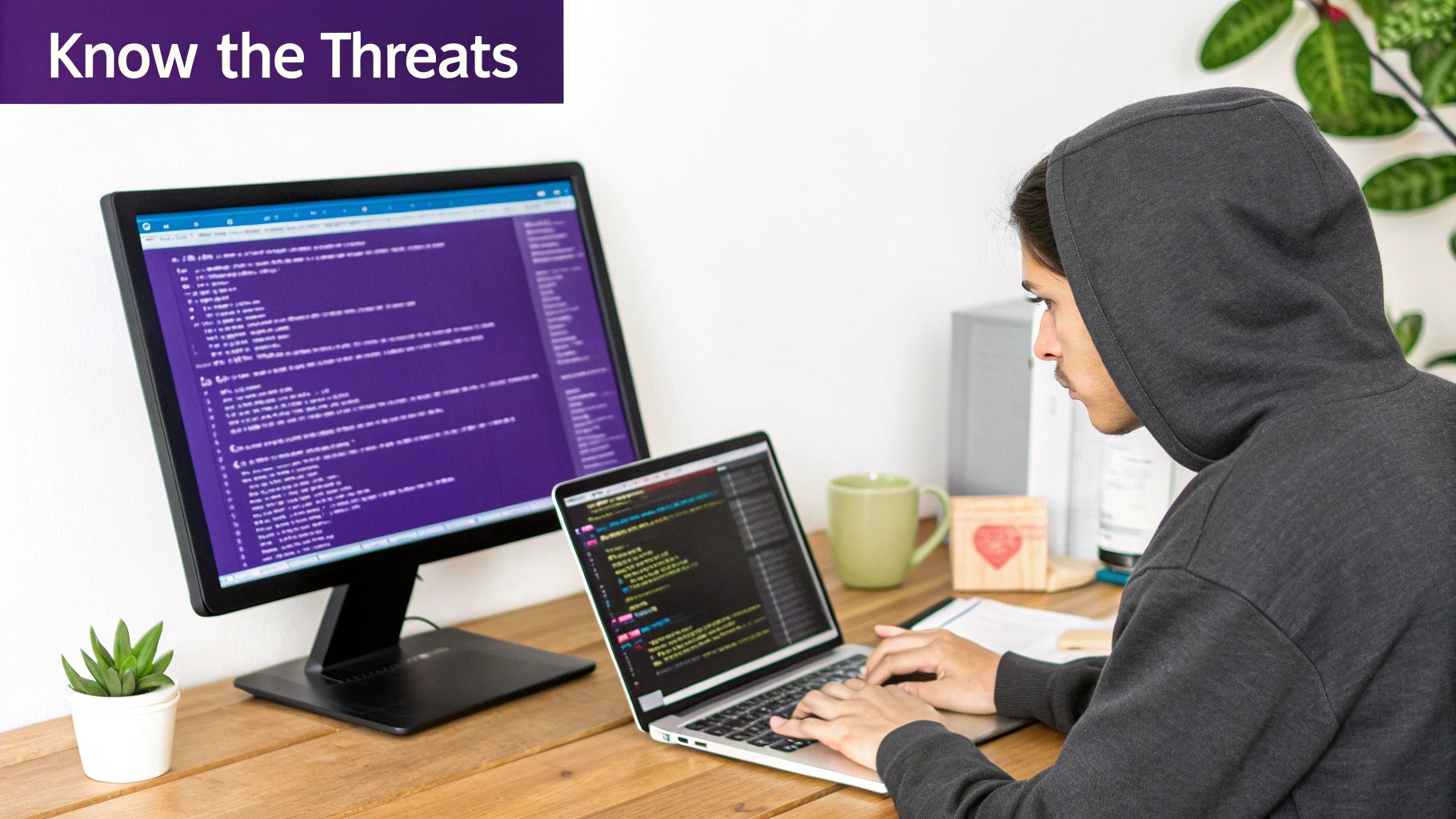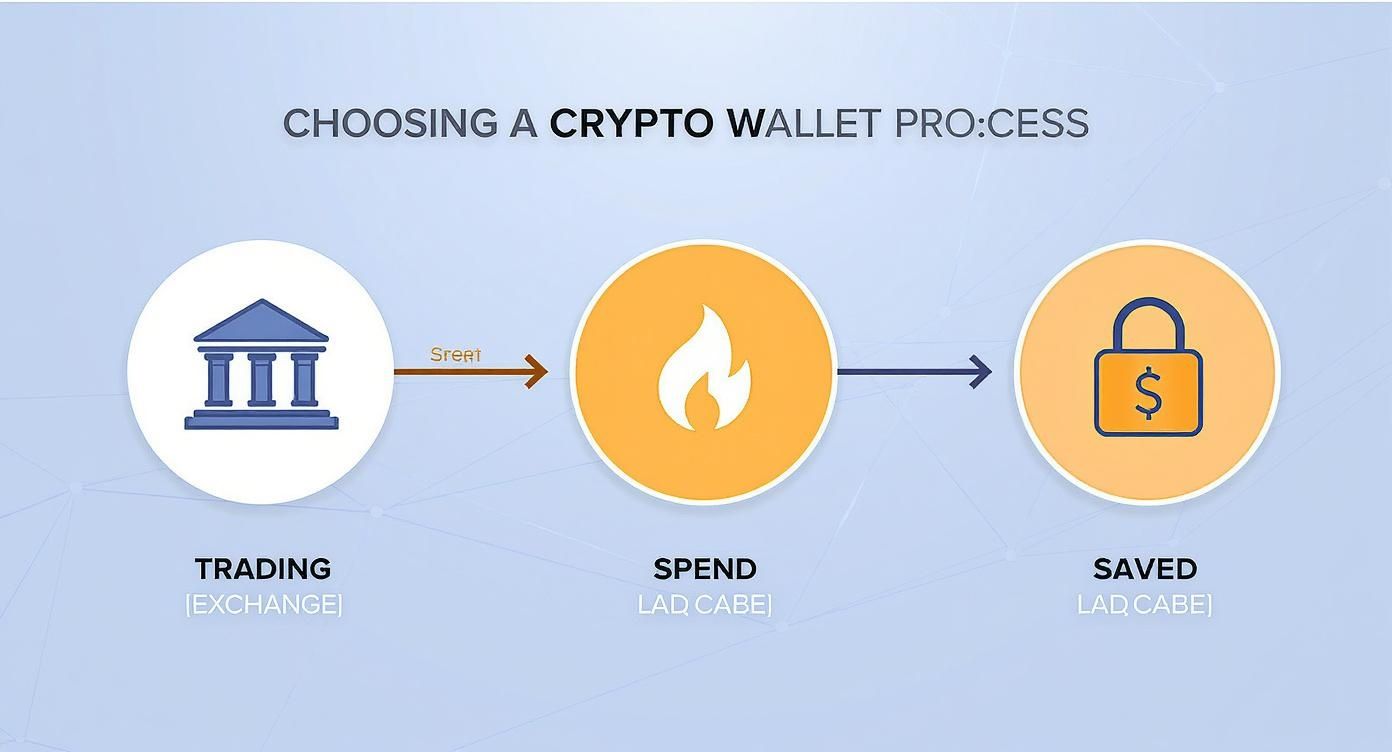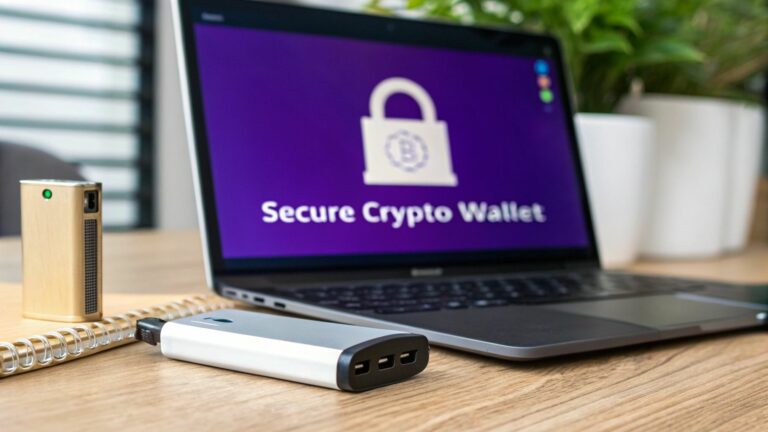Securing your crypto wallet isn't about one magic bullet. It’s a mix of smart habits: protecting your seed phrase like it’s gold, using hardware wallets for any serious amount of crypto, and staying sharp enough to dodge daily scams.
The bottom line is that your private keys are everything. They give anyone who holds them total control of your funds, so protecting them is your number one job.
Understanding Modern Crypto Security Threats

Before you can build a defense, you need to know what you're up against. Securing a crypto wallet is less about buying a specific gadget and more about building a security-first mindset. It's about thinking like a hacker to anticipate their moves and spot the real-world tricks they pull every day.
The game has changed. While big exchange hacks still grab headlines, attackers are now laser-focused on individual users like you and me. Why? Because personal wallets are often the easiest targets.
Recent data shows that compromises of personal wallets now account for a staggering 23.35% of all stolen crypto. This trend is only getting worse as more people enter the space, and attackers get more creative. You can dig deeper into these trends in the 2025 crypto crime mid-year update.
Developing Your Personal Threat Model
A "threat model" sounds technical, but it’s really just a straightforward way to figure out your weak spots. It's not about being paranoid; it’s about being strategic. Start by asking yourself a few honest questions:
- What am I protecting? Is it a small amount of crypto for playing around with, or is it your life savings? The value of your assets dictates how intense your security needs to be.
- Who is trying to get it? Are you worried about a random online scammer, or could you be a specific target? Public figures known to hold crypto face different threats than an anonymous user.
- Where am I most vulnerable? Do you reuse passwords? Ever clicked on a sketchy email link? Is your crypto activity mixed with daily browsing on the same computer? Be real with yourself here.
Answering these helps you focus your energy where it counts. Someone with a huge portfolio should be thinking about advanced cold storage solutions. A beginner should be mastering how to spot a phishing attempt from a mile away.
Key Takeaway: Your security plan has to fit you. A one-size-fits-all approach doesn't work in crypto. Tailor your defenses to the amount you're protecting and how you actually use it.
The Most Common Attack Vectors Today
Forget the Hollywood hacker in a dark room guessing your password. Today’s attacks are slick, subtle, and designed to trick you into making a mistake.
1. Sophisticated Phishing and Social Engineering
This is, without a doubt, the biggest threat to most users. Attackers create pixel-perfect fake websites, emails, and DMs that mimic legitimate platforms like vTrader or MetaMask. Their goal is to bait you into typing in your seed phrase or signing a malicious transaction. They often invent a crisis—a fake "security alert" or "account suspension"—to make you act fast without thinking.
2. Malware and Keyloggers
Malicious software can sneak onto your computer or phone from anywhere—a pirated app, a shady download, or a fake wallet from an unofficial app store. Once it's in, a keylogger can record every single thing you type, including your passwords and seed phrases.
Another nasty trick is the "clipboard hijacker." This malware waits for you to copy a wallet address and silently replaces it with the attacker's address just before you paste. You send the funds, thinking they’re going to the right place, and only realize the mistake when it's far too late.
3. Physical "Wrench Attacks"
It's less common, but physical threats are a real and growing concern, especially for people who are vocal about their crypto holdings online. The so-called "wrench attack" is exactly what it sounds like: an attacker uses physical force or threats to make you hand over your crypto. This is the ultimate reason why it's a terrible idea to broadcast your wealth on social media.
Choosing the Right Wallet for Your Assets
Everything in crypto security starts with one decision: which wallet you use. This isn't just a technical detail—it determines how your private keys are stored, how exposed you are to online attacks, and what your daily experience feels like. Getting your head around the difference between software and hardware wallets is the first real step to protecting your assets.
At its heart, the distinction is straightforward. Software wallets, also known as "hot wallets," are apps or browser extensions that run on your computer or phone. Hardware wallets, or "cold wallets," are dedicated physical devices built to keep your private keys completely offline.
Software Wallets: Convenience and Caution
Software wallets are everywhere, and for good reason. They’re usually free, quick to set up, and perfect for frequent use. If you're diving into DeFi, trading on exchanges like vTrader, or just sending crypto around, the instant access a software wallet provides is hard to beat.
But that convenience comes with a trade-off. Their always-online nature is their biggest vulnerability. Because they live on your main devices, they're exposed to the same threats—malware, phishing scams, and keyloggers. If your computer gets infected, a hacker could find a way into your wallet and empty it.
Real-World Scenario: Let's say you’re an active trader. You use a software wallet to connect to decentralized exchanges and sign off on a dozen transactions a day. For this, a hot wallet is perfect. But you'd only keep your active trading capital in it, not your entire life savings.
Hardware Wallets: The Gold Standard for Security
For anyone serious about holding crypto long-term, a hardware wallet isn't just a good idea—it's essential. These little devices, often resembling a USB stick, generate and store your private keys in a sealed, offline environment. This is what we call cold storage, creating an "air gap" that separates your keys from the internet.
When it's time to make a transaction, you plug the device into your computer. The transaction details are sent to the wallet, but your private key never leaves its secure chip. You physically press a button on the device to approve the transaction, making it nearly impossible for malware on your computer to force a signature or steal your keys.
This offline verification is a game-changer. The latest numbers prove it. In the first half of 2025, the crypto space saw losses top $3.1 billion, with a staggering 70% of that tied to compromised private keys. Hardware wallets with features like air-gapped signing had incident rates under 5%, compared to over 15% for software-only setups. You can see more details in these self-custody wallet statistics on CoinLaw.io.
A Side-by-Side Wallet Comparison
To make the right call, it helps to see everything laid out. Your choice should come down to your own security needs and what you actually plan to do with your crypto.
Here’s a quick breakdown to help you decide.
Wallet Type Security Comparison
| Wallet Type | Private Key Storage | Online Exposure | Best For | Primary Risk |
|---|---|---|---|---|
| Software Wallet | Stored on a connected device (computer or phone). | Always online, making it vulnerable to malware and hacks. | Small amounts, daily transactions, and DeFi interactions. | Compromise of your primary device (e.g., via phishing or keylogger). |
| Hardware Wallet | Stored on a dedicated, offline physical device. | Keys are never exposed to the internet, even during transactions. | Long-term storage of significant crypto holdings ("HODLing"). | Physical loss or damage of the device (if the seed phrase is also lost). |
| Exchange Wallet | Keys are held and managed by the exchange (custodial). | High; depends entirely on the exchange's security infrastructure. | Trading and quick access to funds stored on the platform. | Exchange hacks, freezes on withdrawals, or platform insolvency. |
As you can see, each wallet type serves a distinct purpose. One isn't inherently "better" than another; they're just different tools for different jobs.
The Role of Exchange Wallets
Finally, let's talk about exchange wallets, like the one you have on a platform such as vTrader. When you hold crypto on an exchange, you aren't in control of the private keys—the exchange is. This is what's known as a custodial wallet.
While it’s incredibly convenient for trading, it’s a security model based entirely on trust. You’ve probably heard the phrase, "not your keys, not your coins," and it exists for a good reason. The history of crypto is littered with exchanges that were hacked or went out of business, leaving users with nothing.
The smartest approach is a hybrid one. Keep only what you're actively trading on the exchange. For everything else—your long-term holds—move it to a personal wallet where you control the keys, preferably a hardware wallet. This gives you the best of both worlds: the speed you need for trading and the security you need for peace of mind.
Mastering Your Seed Phrase Security
Your seed phrase sits at the heart of every crypto move you make. It’s more than a backup—it’s your lifeline if your wallet app disappears. This cluster of 12 to 24 words is the only thing standing between you and total control of your funds.
A password locks your wallet software on a device. Your seed phrase is the wallet itself. Lose the phrase and you lose access forever. Anyone who finds it can walk right in, bypassing PINs, biometrics—everything.
This infographic lays out how your main activity—trading versus saving—shapes the way you store that phrase.

As you shift from active trading to long-term holding, you’ll see why offline seed phrase security becomes non-negotiable.
The Unbreakable Rules Of Seed Phrase Management
Treat your seed phrase like a physical vault. Once it touches any connected device, you’ve opened a backdoor for attackers.
• Never Photograph It. Automatic cloud backups and synced devices mean a single snapshot can become a global targeting beacon.
• Never Store It In A Text File Or Document. Malware hunters scan for word lists that match seed-phrase patterns. Don’t give them the prey.
• Never Save It In A Password Manager. Those services are prime hacking targets—your master key deserves better.
• Never Type It Into Any Website. No legit support team or platform, including vTrader, will ever request your recovery phrase. That’s always a scam.
• Never Speak It Out Loud. Smart speakers, recording apps, voice-activated assistants—they’re all listening.
Key Takeaway: Your seed phrase should exist in only one form: a physical copy stored offline. Any digital trace is a vulnerability waiting to be exploited.
Creating Resilient Physical Backups
A scrap of paper won’t survive a flood or a fire. For real peace of mind, invest in backups designed to outlast disasters.
• Laminated Paper: Slip your handwritten phrase into a waterproof, tear-resistant sleeve. Pair it with a fireproof safe or a bank vault.
• Metal Plate Kits: Engrave or stamp your words onto steel or titanium. These plates shrug off flames, floods, and rodents alike.
• Geographic Distribution: Don’t keep every copy under the same roof. One at home, one at a family member’s or a safe deposit box—diversify location risk.
Safely Verifying Your Backup
Building a backup is only half the job—you must be sure it actually works. But testing on your computer is asking for trouble.
• Use your hardware wallet’s built-in recovery test feature. It lets you rehearse a restore on the device’s screen without exposing your words to the internet.
• Keep the test offline at all times. No cameras, no USB-connected PCs—just you and the hardware wallet.
And remember: deleting a file doesn’t obliterate it. For truly safe cleanup of any digital leftovers, explore truly secure data destruction methods.
Mastering your seed phrase security isn’t optional. It’s the bedrock of self-custody and the single most important duty you have as a crypto owner.
Developing Strong Daily Security Habits

Great wallet security isn't a "set it and forget it" kind of thing. It's really about building a set of smart, consistent habits that become second nature. This is your operational security, or "opsec," and it’s your best defense against the constant barrage of attacks targeting crypto users.
These daily practices are what keep your assets safe from attackers who are just waiting for you to make one tired, distracted click. It all begins with creating a clean and secure digital space for your crypto activity.
Fortify Your Digital Environment
Your crypto is only as secure as the device you use to access it. If your computer or phone gets compromised, a hacker has a direct line to your funds, making even the strongest wallet password useless. This is where basic digital hygiene isn't just a good idea—it's essential.
A pro move is to dedicate a specific device, like an old laptop or a burner phone, just for crypto. If you only use it for transactions and never for casual web surfing, email, or social media, you dramatically reduce its exposure to malware and phishing traps.
Also, think of public Wi-Fi as a minefield. These networks are notoriously insecure, giving bad actors an easy way to spy on your activity. Never access your wallet or any exchange account like vTrader on a public network. Stick to a trusted, private connection or get a reputable VPN to encrypt your traffic.
Beyond just good password habits, a secure computing environment is paramount. This includes running regular software updates and choosing the best antivirus software to keep your machine clean.
Key Takeaway: Treat your crypto device like a surgical tool. Keep it clean, use it only for its intended purpose, and protect it from outside contamination. A pristine digital environment is your first and best defense.
Mastering Phishing and Scam Detection
Phishing is, without a doubt, the biggest threat to the average crypto user. Scammers have gotten incredibly good at psychological manipulation, often creating a false sense of urgency to trick you into making a mistake. Their methods change, but the tell-tale signs are usually the same.
- Urgent Threats: Get instantly suspicious of any email or message claiming your account is "suspended" or your funds are "at risk." This is a textbook tactic to make you panic and click before you think.
- Imposter DMs: Scammers love to hang out in Discord, Telegram, and X (formerly Twitter) DMs, pretending to be from a support team. No legitimate support staff will ever DM you first or ask for your seed phrase. Ever.
- Malicious Ads: Be careful with ads that pop up at the top of your search results. They often look identical to official sites. Always, always double-check the URL before clicking anything.
The single best habit you can build to fight this is to always navigate to crypto sites directly using your own bookmarks. Never click links from emails, DMs, or even search results when you're about to log in. This one simple move shuts down a massive number of phishing attacks.
Cultivating a Healthy Skepticism
The final piece of your daily security puzzle is your mindset. In crypto, a healthy dose of skepticism isn't just smart—it's a superpower. You have to learn to look at every interaction through a security-first lens.
Before you act on anything, ask yourself a few questions:
- Is this too good to be true? An unexpected airdrop or a promise of guaranteed returns is almost always a wallet-draining scam.
- Who initiated this contact? If someone you don't know reaches out with an "opportunity" or a "problem," your default assumption should be that it’s a trap.
- Why do they need this information? Be fiercely protective of your data. Never give out personal details or anything related to your wallet to someone who contacts you out of the blue.
Your goal is to make security an automatic reflex. By bookmarking your sites, questioning every unsolicited message, and keeping your devices clean, you build a powerful shield against the vast majority of threats out there. This proactive stance is what really secures your crypto for the long haul.
Implementing Advanced Security Strategies
Now that you’ve solidified your daily security routine, it’s time to add extra layers of defense. Whether you’re safeguarding a small portfolio or a substantial stash, these methods raise the bar on protection.
They’re not just for big institutions. By weaving in redundancies and strategic decoys, you’ll make it far harder for an attacker to hit the jackpot.
Embracing Multisignature Wallets
A multisignature (multisig) wallet works like a vault that won’t open with just one key. Instead of relying on a single private key, you distribute several—and require multiple approvals before funds can move.
A common approach is the 2-of-3 model:
- Store one key on a hardware device.
- Keep the second key on your laptop.
- Place the third key with a trusted friend or in a safe deposit box.
This setup brings clear benefits:
- Theft Prevention: Even if your laptop is compromised, the hacker still needs another key.
- Loss Protection: Losing one key isn’t a disaster—you can recover with the other two.
- Collaborative Control: Perfect for family funds or small businesses where multiple approvals are required.
The Power Of The 25th Word
Most hardware wallets, like Ledger and Trezor, support an extra passphrase—often called the “25th word.” When you add this secret to your 24-word seed, it spawns a completely separate wallet.
That opens up a clever trick: you can fund a small, visible wallet with just the standard seed and stash your real holdings behind the passphrase. In a crisis, you reveal the decoy and keep the bulk of your crypto hidden.
Real-World Scenario: Picture a “wrench attack” where someone forces you to unlock your device. You hand over your PIN, show them the decoy wallet with a modest balance and watch them leave satisfied. All the while, your main holdings remain tucked away in the passphrase-protected account.
Just don’t forget that extra word—if it slips your mind, the hidden wallet disappears forever.
Advanced Cold Storage Concepts
Cold storage isn’t only about owning a hardware device; it’s an offline strategy for both your private keys and recovery backups. To survive disasters—natural or targeted—you need a resilient plan.
Consider these tactics:
- Geographic Distribution: Never keep all backups in one spot. Split your metal seed backups across a home safe, a bank vault, and a trusted relative’s home in another city.
- Decoy Wallets: Mirror your passphrase approach. Create a secondary wallet with a small balance and store its seed phrase in an obvious location. An attacker finds the decoy and overlooks your primary stash.
When you combine multisig arrangements, passphrases, and geographically spread backups, you end up with a security framework that’s redundant, resilient, and ready for almost any threat.
Common Wallet Security Questions, Answered
When you're getting serious about crypto, security questions pop up all the time. Let's cut through the noise and tackle some of the most common concerns head-on.
What’s the Absolute Safest Type of Crypto Wallet?
Hands down, a hardware wallet is the most secure option for almost everyone. It’s designed to do one thing and one thing only: keep your private keys completely offline. This creates a physical barrier—an "air gap"—that makes it impossible for online threats like malware or a sneaky phishing link to get anywhere near your funds.
Software wallets are great for convenience and everyday transactions, but they simply can’t offer the same fundamental protection. If you have an amount of crypto you'd be devastated to lose, a hardware wallet isn't just a good idea; it's the gold standard.
Are Mobile Wallets Actually Safe?
They can be, but their safety is a direct reflection of your own digital habits. Mobile wallets are "hot wallets," meaning they're always connected to the internet. This exposes them to the same risks your phone faces every day—a malicious app download, a fake text message with a bad link, or even an attack on a public Wi-Fi network.
You can definitely harden your mobile wallet's defenses:
- Use Biometrics: Always turn on Face ID or fingerprint scanning. It's a simple but effective barrier.
- Ditch Public Wi-Fi: Never, ever manage your crypto in a coffee shop, airport, or on any other unsecured network.
- Practice Good Phone Hygiene: Only install apps from official stores and always keep your operating system up to date.
Even with these steps, think of a mobile wallet as your pocket money. It’s perfect for small, spendable amounts, not for storing your life savings.
Can I Get My Funds Back If I Lose My Private Key?
No. Let's be crystal clear here: if you lose your private key and your seed phrase backup, your crypto is gone for good. There’s no "forgot password" link, no support team to call. Your seed phrase is the one and only master key to your funds.
Key Insight: This is exactly why getting your seed phrase management right is non-negotiable. Losing your hardware wallet is an annoyance; you can just buy a new one. Losing your seed phrase is a total disaster. You need multiple, durable, offline backups stored in different, secure locations.
Is a Hardware Wallet Really Safer Than an Exchange Like vTrader?
Yes, a hardware wallet is exponentially safer for holding your crypto long-term. When your funds are on an exchange, you're relying on their security team to protect them. This is called custodial storage—you don't actually control the keys to your own money.
Exchanges are massive targets for hackers, and history is littered with stories of nine-figure heists. A hardware wallet, on the other hand, gives you self-custody. You, and only you, hold the keys. This completely removes the risk of an exchange getting hacked, freezing your withdrawals, or going bankrupt. The best strategy? Trade on the exchange, but store your serious investments on your own hardware device.
Ready to trade with confidence on a platform that prioritizes your security? vTrader offers zero-fee trading, advanced tools, and a secure environment registered with FinCEN. Start building your portfolio with a $10 sign-up bonus today!

Steve Gregory is a lawyer in the United States who specializes in licensing for cryptocurrency companies and products. Steve began his career as an attorney in 2015 but made the switch to working in cryptocurrency full time shortly after joining the original team at Gemini Trust Company, an early cryptocurrency exchange based in New York City. Steve then joined CEX.io and was able to launch their regulated US-based cryptocurrency. Steve then went on to become the CEO at currency.com when he ran for four years and was able to lead currency.com to being fully acquired in 2025.


